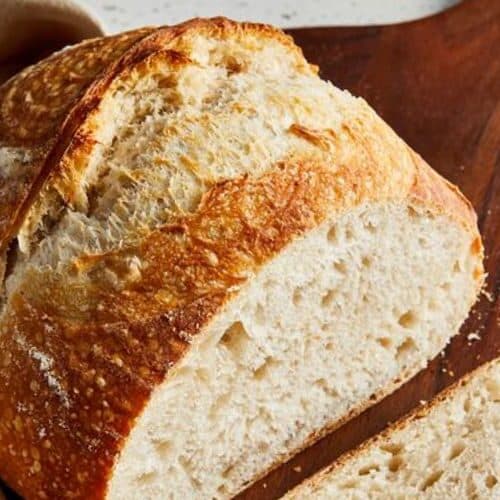
Gluten-Free Sourdough Bread
This gluten-free sourdough bread offers the same tangy flavor and chewy texture as traditional sourdough, with none of the gluten. Made from a gluten-free starter and a blend of gluten-free flours, it’s perfect for those with dietary restrictions or anyone seeking a delicious, homemade bread alternative. The process requires patience, but the result is a beautiful, golden-brown loaf with a crispy crust and a light, airy crumb.
Equipment
- Stand Mixer or Hand Mixer (optional): 1
- Mixing bowls (2-3)
- Dutch oven or Baking cloche (1, optional)
- Proofing Basket (optional): 1
- Baking Sheet (1)
- Sharp knife or razor blade (for scoring)
- Wire cooling rack (1)
Ingredients
For the Sourdough Starter:
- 1 cup 120g gluten-free flour (rice flour, sorghum, or a gluten-free blend)
- 1 cup 240ml warm water (non-chlorinated)
For the Bread:
- 1 ½ cups 180g gluten-free flour (sorghum, rice flour, or a gluten-free blend)
- 1 ½ cups 180g gluten-free all-purpose flour (for structure)
- 1 tsp 5g salt
- 2 tbsp 30ml olive oil (or another oil of choice)
- 1 ½ cups 360ml water (room temperature)
- 1 tbsp 15g sugar (helps with fermentation)
- 2 tsp 6g active dry yeast (optional for extra rise)
- ½ tsp 1g xanthan gum (for texture)
- Gluten-free sourdough starter 1 cup, active and bubbly
Instructions
Make the Sourdough Starter:
- Mix 1 cup gluten-free flour with 1 cup warm water in a clean jar. Cover loosely and leave at room temperature for 24 hours. Feed it daily for 5-7 days, discarding half and adding ½ cup flour and ½ cup water daily until bubbly and sour-smelling.
Prepare the Dough:
- In a large bowl, mix the gluten-free flours, salt, xanthan gum, and sugar.
- Add the sourdough starter, olive oil, yeast (if using), and water to the dry ingredients. Mix well with a stand mixer or by hand using a wet spatula until a sticky dough forms.
- Let the dough rest for 30 minutes.
Proof the Dough:
- Cover the dough with a damp cloth or plastic wrap and let it rise in a warm place for 4-6 hours or until slightly puffed, though it may not double in size.
Shape the Loaf:
- Gently shape the dough into a round or oval loaf. Place it into a proofing basket or onto a baking sheet lined with parchment paper.
Bake the Bread:
- Preheat the oven to 450°F (230°C). If using a Dutch oven, preheat it as well.
- Score the top of the dough with a sharp knife and place it into the oven. Bake for 40-45 minutes or until the crust is golden and the bread sounds hollow when tapped on the bottom.
Cool:
- Remove the bread from the oven and cool on a wire rack for at least 1-2 hours before slicing.
Notes
- Starter Care: Ensure your sourdough starter is active and bubbly before using it in the recipe. If it’s not rising properly, it might need more time or a slightly warmer environment.
- Hydration Levels: Gluten-free dough tends to be wetter than traditional bread dough. Don’t worry if it’s sticky—this is normal!
- Freezing: To preserve the bread for longer, slice it and freeze individual slices. You can toast them straight from the freezer.
- Flour Choices: Experiment with different gluten-free flour blends. Rice flour and sorghum flour give the best texture, but you can mix them with oat flour or millet flour for added flavor.